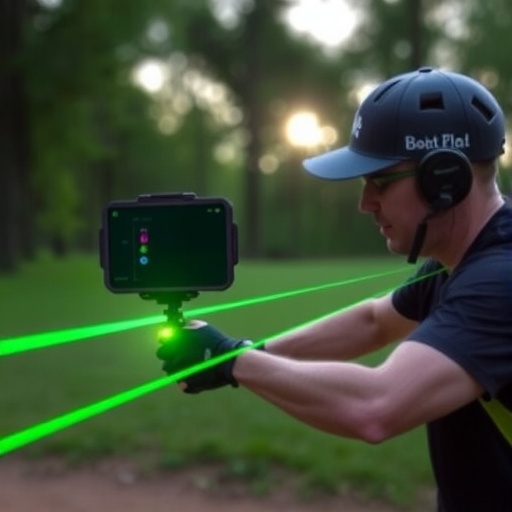PROTECT YOUR DNA WITH QUANTUM TECHNOLOGY
Orgo-Life the new way to the future Advertising by Adpathway
In the realm of sports science, one of the most critical parameters for evaluating athletic performance is the measurement of high-speed running. Traditional methods of monitoring these metrics often involve cumbersome equipment or subjective interpretations, which can lead to discrepancies in data accuracy. However, a recent study published in Sports Engineering presents a method that may revolutionize how we assess athletic speed in outdoor settings through the use of an innovative laser device. This validation study, conducted by an expert research team led by G.M. Duthie, S. Robertson, and K. Ball, demonstrates the reliability and applicability of the laser technology in real-world team sport scenarios.
The motivation behind developing such technology stems from the need for precision in sports assessments. Athletes and coaches require data that can enhance training regimens, prevent injuries, and improve overall performance. Conventional timing systems, such as stopwatches or handheld devices, are prone to human error and can face challenges in outdoor environments. The laser device explored in this study aims to offer a more accurate and efficient means of capturing high-speed running data, ensuring that performance metrics are both valid and reliable.
The intricate design of the laser device not only allows for accurately measuring time but also incorporates advanced technology that analyzes speed over varying distances. This dual functionality is essential because sprinting performance can fluctuate based on numerous factors, including environmental conditions and fatigue levels. Unlike traditional methods, the laser system provides instantaneous feedback, allowing athletes to monitor their performance in real time. As athletes engage in high-speed runs, coaches can utilize this data live during training sessions, facilitating immediate adjustments to techniques and strategies.
In terms of validation, the initial studies involved test runs to compare the laser device’s readings against established standards. Researchers meticulously designed experimental protocols that ensured the reliability of the data collected. Various distances were tested, and adjustments were made to account for potential variances in environmental conditions, such as wind speed and surface type. This attention to detail underscores the research team’s commitment to developing a trustworthy tool for measuring high-speed performance accurately.
The results from these validation studies revealed a strong correlation between the readings from the laser device and those obtained from traditional timing methods. As the researchers meticulously analyzed the gathered data, it became evident that the laser device not only matched but often exceeded the accuracy of conventional systems. This finding builds a robust foundation for the device’s integration into various team sports, where real-time data could lead to enhanced performance monitoring.
Moreover, the implications of this technology extend beyond simple measurements. Understanding the dynamics of sprinting and high-speed running can profoundly influence training methodologies. For instance, the ability to gather comprehensive data on an athlete’s performance can help coaches tailor training programs to individual needs, focusing on specific areas of improvement and optimizing performance outcomes. The study underlines the importance of integrating technology into sports science, asserting that advances such as these can significantly contribute to athlete development.
As the study highlights, the laser device offers significant advantages in outdoor settings, a domain often prone to the variability of environmental factors that can disrupt traditional measurement methods. One of the critical benefits of using such equipment is its setup versatility. The device can be adjusted swiftly for different training circumstances, making it an appealing option for teams that frequently change locations for practices and games. It positions itself as a robust and adaptable solution capable of evolving with the intricacies of outdoor team sports.
Notably, the success of the laser device also hinges on its user-friendly interface. In an environment where time is of the essence, especially during training sessions, ease of use plays an important role. The study emphasizes how intuitive the system is, enabling coaches and athletes alike to familiarize themselves with the technology quickly. Furthermore, the ease of data interpretation ensures that valuable insights can be extracted with minimal downtime, keeping training sessions both efficient and productive.
The study also opens discussions about the future of performance assessment in sports. As technology continues to advance, the potential applications range from integrating artificial intelligence to analyze data trends to the possibility of wearing smart sensors that provide athletes with immediate feedback on their biomechanics. This validation of laser technology marks just the beginning, sparking a wave of innovation in sports performance measurement tools that could set new standards in athlete training and development.
Another crucial aspect highlighted in the study is the potential for scalable applications across various sports disciplines. While the current focus is primarily on high-speed running, the underlying principles can be adapted for other sport-specific assessments as well. Whether measuring sprint times in soccer, analyzing runner performance in track events, or even evaluating speed in rugby, the possibilities for applying this technology appear limitless. This versatility would ensure that the device has significant longevity and relevance in the ever-evolving landscape of sports science.
Moreover, as the sports industry increasingly focuses on data-driven approaches, tools like the laser device become vital. It places an emphasis on performance metrics and athlete conditioning, ushering in an era of analytics that empowers athletes and coaches alike. Organizations that adopt these advanced technologies will likely see an edge in competitive advantage as the precision of training data correlates directly with athlete improvement.
In conclusion, this validation study shines a light on the potential of the laser device to transform how high-speed running is assessed in outdoor sports. The integration of such technology into sports performance evaluation represents a significant leap forward in accuracy, efficiency, and usability. As research continues to unfold, the sports community stands on the brink of a new frontier where data and technology converge to facilitate athlete development, optimize training techniques, and ultimately enhance competitive performance.
The transition from theory to practice will determine the future widespread adoption of such devices. The sports sector is watching keenly as researchers and practitioners alike recognize the profound implications of accurate performance metrics. As the laser device proves its efficacy in real-world scenarios, it could very well become a standard tool in athletic training and performance evaluation.
Subject of Research: Validation of a laser device for assessing high-speed running in outdoor team sport settings
Article Title: Validation of a laser device for assessing high-speed running in an outdoor team sport setting.
Article References:
Duthie, G.M., Robertson, S., Ball, K. et al. Validation of a laser device for assessing high-speed running in an outdoor team sport setting.
Sports Eng 28, 25 (2025). https://doi.org/10.1007/s12283-025-00509-4
Image Credits: AI Generated
DOI: 10.1007/s12283-025-00509-4
Keywords: High-speed running, Laser device, Sports performance measurement, Team sports, Validation study.
Tags: advancements in sports engineeringeffective outdoor sports metricsenhancing athlete training regimenshigh-speed running measurementinjury prevention in sports.innovative athletic assessment toolslaser technology in sportsprecision in sports trainingreducing human error in timingreliability of sports performance datateam sport performance evaluationvalidating outdoor sports performance


 6 hours ago
6
6 hours ago
6





















 English (US) ·
English (US) ·  French (CA) ·
French (CA) ·